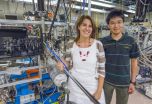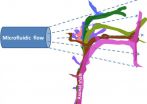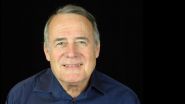A quick look at electron-boson coupling
Berkeley Lab researchers use ultrafast spectroscopy on many body effects
2014-10-06
(Press-News.org) Imagine being able to tune the properties of a solid material just by flashing pulses of light on it, for example turning an insulator into a superconductor. That is just one potential payoff down-the-road from the physical phenomenon of electrons and atoms interacting with ultrashort pulses of light. The technology of ultrafast spectroscopy is a key to understanding this phenomenon and now a new wrinkle to that technology has been introduced by Berkeley Lab researchers.
In a study led by Alessandra Lanzara of Berkeley Lab's Materials Sciences Division, time- and angle-resolved photoemission spectroscopy (trARPES) was used to directly measure the ultrafast response of electron self-energy - a fundamental quantity used to describe "many-body" interactions in a material – to photo-excitation with near-infrared light in a high-temperature superconductor. The results demonstrated a link between the phenomena of electron-boson coupling and superconductivity. A boson can be a force-carrying particle, such as a photon, or composite particle of matter, such an atomic nucleus with an even number of protons and neutrons.
"Below the critical temperature of the superconductor, ultrafast excitations triggered a synchronous decrease of electron self-energy and the superconducting energy gap that continued until the gap was quenched," says Lanzara. "Above the critical temperature of the superconductor, electron–boson coupling was unresponsive to ultrafast excitations. These findings open a new pathway for studying transient self-energy and correlation effects in solids, such as superconductivity."
The study of electrons and atoms interacting with intense, ultra-short optical pulses is an emerging field of physics because of the roles these interactions play in modulating the electronic structures and properties of materials such as high-temperature superconductors. ARPES has been the long-standing technique of choice for studying the electronic structure of a material. In this technique, beams of ultraviolet or X-ray light striking the surface or interface of a sample material cause the photoemission of electrons at angles and kinetic energies that can be measured to reveal detailed information about the material's electronic band structures. While extremely powerful, ARPES lacks the temporal component required for studying band structural dynamics.
Lanzara and a collaboration that included Wentao Zhang, lead author of a paper on this work in Nature Communications, added the necessary temporal component in their trARPES study. They applied this technique to a material known as Bi2212, a compound of bismuth, strontium, calcium, and copper oxide that is considered one of the most promising of high-temperature superconductors. They energized the Bi2212 samples with femtosecond pulses of near-infrared laser light then probed the results with femtosecond pulses of ultra-violet laser light. The
delay time between pump and probe pulses was precisely controlled so that the electron-boson coupling and the superconducting gap could be tracked at the same time.
"In cuprate materials such as Bi2212, there is a known kink in the photoemission pattern that signifies the coupling of the electrons to bosons," says Zhang. "However, whether this kink is related in any way to superconductivity has been highly debated. Our results show that it is."
INFORMATION:
Zhang's Nature Communications paper, for which Lanzara is the corresponding author, is titled "Ultrafast quenching of electron–boson interaction and superconducting gap in a cuprate." Other co-authors are Choongyu Hwang, Christopher Smallwood, Tristan Miller, Gregory Affeldt, Koshi Kurashima, Chris Jozwiak, Hiroshi Eisak, Tadashi Adachi, Yoji Koike and Dung-Hai Lee.
This research was supported by the U.S. Department of Energy's Office of Science.
Lawrence Berkeley National Laboratory addresses the world's most urgent scientific challenges by advancing sustainable energy, protecting human health, creating new materials, and revealing the origin and fate of the universe. Founded in 1931, Berkeley Lab's scientific expertise has been recognized with 13 Nobel prizes. The University of California manages Berkeley Lab for the U.S. Department of Energy's Office of Science. For more, visit http://www.lbl.gov.
[Attachments] See images for this press release:

ELSE PRESS RELEASES FROM THIS DATE:
2014-10-06
Rabies causes acute inflammation of the brain, producing psychosis and violent aggression. The virus, which paralyzes the body's internal organs, is always deadly for those unable to obtain vaccines in time. Some 55,000 people die from rabies every year.
For the first time, Tel Aviv University scientists have discovered the exact mechanism this killer virus uses to efficiently enter the central nervous system, where it erupts in a toxic explosion of symptoms. The study, published in PLOS Pathogens, was conducted by Dr. Eran Perlson and Shani Gluska of TAU's Sackler Faculty ...
2014-10-06
Obesity is a risk factor for many health problems, but a new Penn Medicine study published this month in the journal Sleep suggests having a larger tongue with increased levels of fat may be a sign of obstructive sleep apnea (OSA) in obese adults.
The researchers examined tongue fat in 31 obese adults who had OSA and 90 obese adults without the condition. All subjects underwent magnetic resonance imaging and the size and distribution of upper airway fat deposits in their tongue and upper airway muscles measured.
"Previous studies showed that the human tongue has a high ...
2014-10-06
A University of Texas at Arlington team exploring how neuron growth can be controlled in the lab and, possibly, in the human body has published a new paper in Nature Scientific Reports on how fluid flow could play a significant role.
In a new study co-authored by Samarendra Mohanty, leader of the Biophysics and Physiology Lab in the College of Science, the researchers were able to use microfluidic stimulations to change the path of an axon at an angle of up to 90 degrees. Axons are the shafts of neurons, on the tips of which connections are made with other neurons or cells. ...
2014-10-06
URBANA, Ill. – Hardly a day passes without pundits crying for leadership in the NFL commissioner and team owners, among high-ranking government officials, and in other public figures. If University of Illinois experts didn't have evidence that this valuable trait can be taught, they might join the collective swoon that's engulfing much of the country.
But a new U of I study supports the idea that leaders are made, not born, and that leadership development follows a specific progression.
Past research suggests that leadership is 30 percent genetic and 70 percent a result ...
2014-10-06
WEST LAFAYETTE, Ind. - Purdue researchers have identified a set of genes that can be used to naturally boost the provitamin A content of corn kernels, a finding that could help combat vitamin A deficiency in developing countries and macular degeneration in the elderly.
Professor of agronomy Torbert Rocheford and fellow researchers found gene variations that can be selected to change nutritionally poor white corn into biofortified orange corn with high levels of provitamin A carotenoids - substances that the human body can convert into vitamin A. Vitamin A plays key roles ...
2014-10-06
NEW YORK (October 6, 2014) – Investigators at The Children's Hospital at Montefiore (CHAM) and Albert Einstein College of Medicine of Yeshiva University will present their latest research on neonatal lung disease, reducing wrong-patient errors in the NICU, hormonal contraception and more at the AAP Experience, the National Conference & Exhibition of the American Academy of Pediatrics. The AAP Experience will take place October 11-14 in San Diego, California.
Judy Aschner, M.D., F.A.A.P., physician-in-chief, CHAM, professor of pediatrics and Michael I. Cohen, M.D., University ...
2014-10-06
Hamilton, ON (October 6, 2014) – A research study out of McMaster University has found that only 40 per cent of Canadians exercise to cope with stress.
The researchers analyzed data from Statistics Canada's Canadian Community Health Survey of nearly 40,000 Canadians 15 and older. Of 13 coping behaviours or strategies polled, exercise was ranked eighth, meaning people were more likely to cope with stress by problem-solving; looking on the bright side, trying to relax, talking to others, blaming oneself, ignoring stress or praying, rather than being active.
"We know ...
2014-10-06
AUGUSTA, Ga. - The initial motivation was to estimate the age structure of a fruit fly population, the result a fundamental theorem that can help determine the age distribution of essentially any group.
This emerging theorem on stationary populations shows that you can determine the age distribution of a population by looking at how long they still have to live.
The mathematical discovery can help produce data with a wide range of implications, from predicting rates of infectious diseases, such as West Nile virus spread by mosquitoes, to anticipating the health care ...
2014-10-06
WASHINGTON, Oct. 6, 2014— Melanoma is the fifth most common cancer type in the United States, and it's also the deadliest form of skin cancer, causing more than 75 percent of skin-cancer deaths. If caught early enough though, it is almost always curable. Now a camera, capable of taking snapshots of the entire human body and rendering high-resolution images of a patient's skin may help doctors spot cancer early and save lives.
Developed by a team of researchers at Duke University in North Carolina, USA, the "gigapixel whole-body photographic camera" is essentially three ...
2014-10-06
Many US patients with liver cancer—even those with early stage disease that can often be cured—do not receive treatment for their disease, according to an analysis of studies published between 1989 and 2013.
Less than one fourth of patients undergo curative treatment, and nearly 50% do not receive any treatment. Elderly, non-Caucasians and patients of low socioeconomic status had lower treatment rates than their counterparts.
"We found the low treatment rates among patients with early stage tumors particularly concerning. Many of these patients currently fail to receive ...
LAST 30 PRESS RELEASES:
[Press-News.org] A quick look at electron-boson coupling
Berkeley Lab researchers use ultrafast spectroscopy on many body effects




